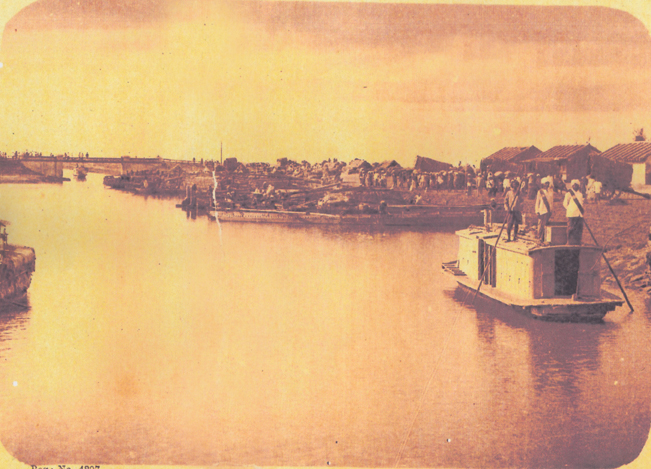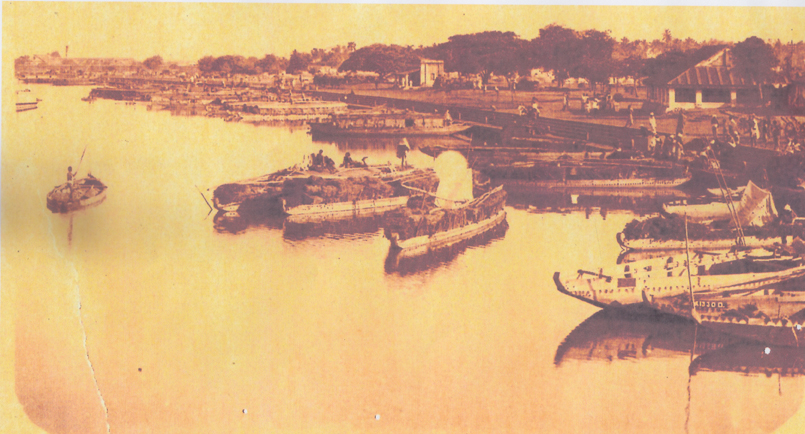
An 1898 view of a passenger boat in the inlet at 143rd mile (near Tummamalapenta, Kavali, Nellore District). |

Iron girder bridge and wharf at Kottapatam, in 1898.
|

Madras Basin, an 1898 view.
Recently, S. Satyanidhi, formerly of the Salt Department and now of 44/3, Satyamurthy Street, Devaraj Nagar, Saligramam, Chennai 600 093, sent us these three pictures of boats that plied in the Buckingham Canal. And reader Ramineni Bhaskarendra Rao sent us this entry on the Canal in the Asylum Press Almanac 1888 together with translations of excerpts (footnoted) from a few Telugu newspapers of the time.
– The Editor
BUCKINGHAM CANAL, P.W. ESTABLISHMENT
C. Vincent, Esq., A.M.I.C.E. ... Executive Engineer – Office Pulicat.
M.R. Ry. N. Ratnasabapathy Assistant Engineer,
Pillay, Rai Sahib. B.A., B.C.E ... 1st Grade – Sub-Divisional Office, Ramapatam.
Conductor J. Power ... Sub-Engineer, Madras Sub-Division Officer – Office,
Madras Basin.
Mr. H.M. Bond ... Sub-Engineer, Eskapilly Sub-Division Officer – Office, Eskapilly.
Conductor J. Lalor ... Sub-Engineer, in charge Pulicat Sub-Division, Pulicat.
Mr. J.R.D. Hendrick ... Supervisor, Kartoor.
Mr. C.H.R. Morton ... Overseer, Covelong.
C. Vartharaju Mudily ... Temporary Overseer, Ennore.
Mr. R. Enright ... Supervisor, Dugarazapatnam
D. Venkataswamy Naidu ... Overseer, Kotapatam.
P. Narayanaswamy Naidu ... Do. Sadras.
This canal is a salt water tidal channnel; runs nearly parallel to the Coastline, and very close to it. It extends from Madras northward, 196 miles, where it joins the fresh water high level Kistna system of canals, the junction being effected by a two-chambered lock, the Kistna system being 7 feet higher: the Kistna system of canals being connected with that of the Godavari, through communication is therefore available to Coconada and elsewhere northward in the Godavari District, Southward of Madras, the canal is cut as far as Alambarai, where it is joined with the Mercanum backwaters, and by this backwater, which is some 12 miles in extent, there is water communication up to Mercanum in the South Arcot District. The total distance of navigable waterway is over 460 miles.
In the Buckingham Canal are absorbed the old Cochrane’s Canal and the East Coast Canal. The extension of these canals during the famine of 1876-78 was one of the most important works executed during that period, when the northern and southern canals were also planned by means of the junction canal, the whole now forming one system of some 256 miles.
The canal is gradually approaching to a complete and efficient condition. A large estimate, over some 30 lacs of rupees, is now being worked out, which provides for completing the canal thoroughly and for making it a safe means of navigation. The estimate provides for abandoning all backwaters; for providing means (flood gates) at all river and large drainage crossings to shut off floods and for giving the canal a proper section, by which 3 feet depth, below the lowest tide level known, will be secured. The canal will thus have about 4 feet water at least except during the periods of the lowest tides of the year.
The total estimated cost of the project is Rs.63,87,100 including expenditure from its commencement.
The different descriptions of boats plying on canal are, the Madras top boat; the Madras open cargo boat, principally employed in the shell and firewood traffic; the Northern cargo boat, called Dinghees; the Northern Rahadaree boat, which are passenger boats, but carry cargo as well, and are of very large carrying capacity, and well protected. The great drawback on the canal is the want of suitable cabin boats for European travellers: there are a few budgrows so called, but these boats were originally built for short passages only, so offer no convenience for long journeys.
The Steam Company endeavouring to do business on the canal, has gone into liquidation. The time has not arrived for introducing steam traffic on the canal.
The following are the towns and other places of some consequence on the northern canal: Ennore, Pulicat, Coromandel, Doorgaraipatam, Kristnapatam (where the Nellore traffic is shipped and unshipped, Nellore distant 16 miles), Eskapally, Ramapatam (station of the American Baptist Mission), Kotapatnam, which is 2 miles from canal on east side while Ongole is 8 miles off on west side by road. The junction of the canal, with that of the Kristna Canal, is at Peddaganjam, on 196th mile of the canal.
The present toll stations of canal are at Shadeyancoopum Lock (8 mile), Kristnapatam (92), Kottapatam (178), on north canal. On the south canal, the only toll station is at Adyar.
On the southern canal, the most important places are Covelong (15), Mahabalypuram or Seven Pagodas (28½), Sadras (36).
There are bungalows on the canal at Sadras, Ennore, Coromandel, Kistnapatam, Eskapally, Ramapatam, Kanaparty, belonging to the canal.
Annual licence fees:– Cargo boats 2½ Rs. per ton of 50 cubic feet, which entitles the vessel to use all the canals, without any further payment.
Passenger boats, 1st Class, Rahadaree, 5 Rs.per ton.
Do do. 2nd Class, do. 3 “ “
Do do. Budgrows 5 “ “
Do do. Top boats 3 “ “
1st Class Rahadaree and budgrows, paying 5 Rs. per ton can charge any rate. 2nd Class Rahadaree and Top boats, 2 pice per mile per passenger, in the general cabin or roof, or 3 pice in the separate cabins. The space per passenger is 7½ square feet, a cooly head-load of baggage is allowed each.
Passenger boats are allowed to carry cargo as well as passengers.
There is no fixed tariff for cargo.
* * *
Footnote: The Buckingham Canal Project necessitated the Ferries Act to be introduced in Madras Presidency.
The Northern India Ferries Act came into force in 1878 (Act 17 of 1878). The Bengal Ferries Act came into force in 1885, only after the Buckingham Canal Project became fully operational The Canals and Public Ferries Act (Act ll of 1890) of Madras came into force in 1890. There was some resistance from some quarters in the Presidency against the implementation of the Act. In 1928, when the Madras Government intended to ban the Steam Boats, citing an order of the High Court of Madras, between Narasapur and Razole in Godavari Dist under rule 29, which was framed in 1895, the people of Narsapur sent a memoire to the Madras Government requesting it not to implement the order as they would be deprived of cheap transport facility.
In the year 1920 Madras Government issued a notice saying that due to the repairs and development works to be underatken at Pententiary Bridge(Central Prison Bridge), the boats plying in the Cooum River are stopped till further notice. The boats going towards Periamet and Chintadripet from North Buckingham Canal were advised to take Northern Branch Canal of Cooum till further notice. It is further informed the boat operators to maintain less than 20 tons of goods in the boat, while going under the Walaja Bridge, since the vertical clearance under the Bridge wont allow the boats with more luggage.
Government officials went by the boats to inspect the Canal during the early days.
|

